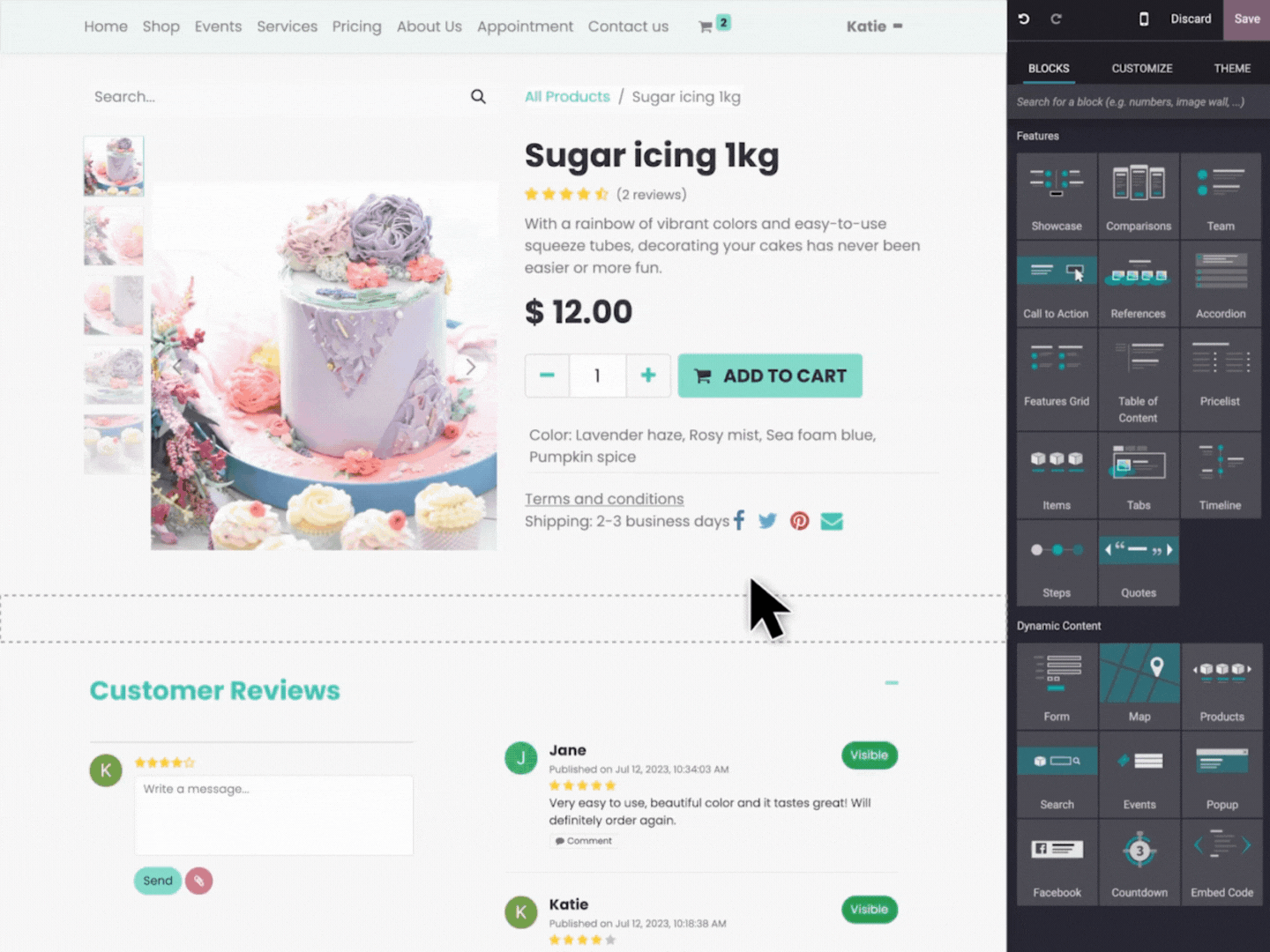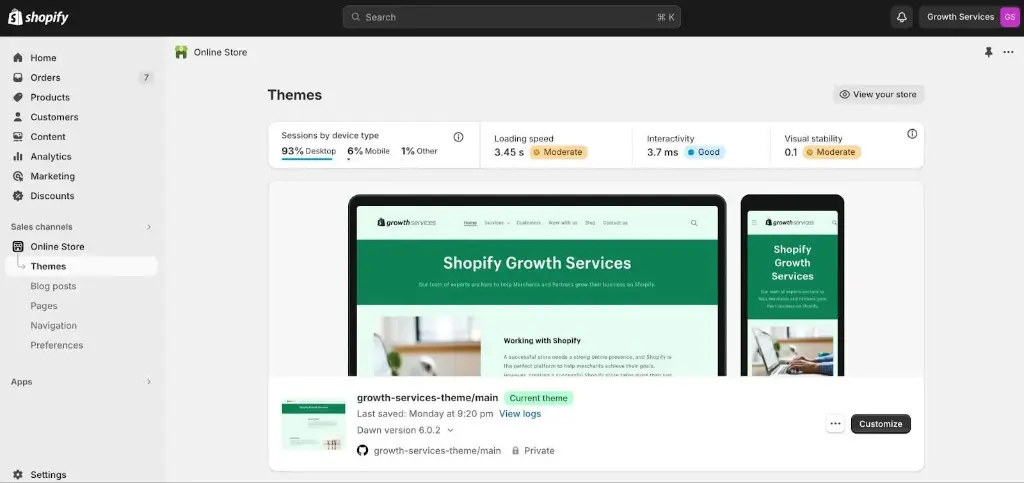Deciding between Odoo eCommerce and Shopify depends on your business's specific needs.
This guide will help you understand the strengths and limitations of each platform, explore integration possibilities, and provide insights into their future developments.
Odoo eCommerce is part of a full business system
Odoo eCommerce is a fully integrated part of the Odoo business suite.
Unlike standalone eCommerce platforms, it connects directly with sales, inventory, accounting, CRM and more, right out of the box. It’s built for businesses that want full control over their operations, all in one system.
Quick facts:
- Current Version: Odoo 18
- Hosting Options: Odoo.sh (cloud), on-premises
- License: commercial (open-source)
- Pricing: Starting at €24.90/user/month
Best for you if:
- You already use or plan to use Odoo for ERP, CRM, or inventory
- You want a fully integrated backend without connectors
- You sell B2B, B2C, or hybrid and want native multichannel features
- You want to manage everything in one system (shop, sales, support, etc.)
Not ideal if:
- Your store requires high-end design flexibility or niche themes
- You don’t use Odoo for anything else
- You rely on many third-party eCommerce apps and widgets
- You need enterprise-grade frontend performance with extreme traffic

Shopify is built for fast, scalable selling
Shopify is a cloud-based eCommerce platform designed for fast setup and ease of use. It’s popular among B2C and D2C retailers and offers a large app ecosystem with themes and plugins for nearly any need.
Quick facts:
- Current version: Shopify Plus (for enterprise), regular tiers for SMBs
- Hosting: Fully hosted SaaS
- License: Proprietary
- Pricing: From €24/month + transaction fees + app costs
Best for you if:
- You want to launch fast with minimal setup or code
- You prioritise design, themes, UX, and customer journey
- Your team isn’t technical and prefers a no-code environment
- You run high-volume B2C shops and rely on third-party tools
Not ideal if:
- You need deep backend logic (e.g. manufacturing, custom pricing)
- Your ops depend on inventory, B2B, or warehouse automation
- You want real-time integration with internal systems without middleware
- You want to avoid stacking apps and recurring fees

Odoo eCommerce vs Shopify at a glance
Odoo eCommerce and Shopify are built with different priorities in mind.
Odoo focuses on deep integration and operational control across your entire business, while Shopify prioritises ease of use and fast storefront setup.
The right fit depends on how much complexity you're managing or how much you're planning to grow:
Feature / Capability | Odoo eCommerce | Shopify |
Platform model | Part of all-in-one business suite | Standalone eCommerce platform |
Backend integration | Native with inventory, accounting, CRM | Requires apps or external tools for backend logistics |
Order volume capacity | Can handle 5K orders/day via connected backend | Can support over 100K+ orders/day on the storefront |
Customisation | Open-source and fully adaptable | Theme/app-based; API access on higher tiers |
Multichannel & B2B | Built-in B2B, POS, and multichannel | Primarily B2C; B2B via third-party apps |
Pricing | From €24.90/user/month | From €24/month (Shopify Basic) plus apps and transaction fees |
Ideal use case | SMBs using Odoo as a backend suite | D2C stores focused on design, scalability, and ease of use |
The third way: Odoo Shopify integration
If you love Shopify’s frontend but want Odoo’s power in the backend, there’s a solution: integrate them.
A Shopify & Odoo integration lets you keep your storefront in Shopify and manage everything else in Odoo, from products to stock, orders, accounting and more. It’s the best of both worlds: top-tier customer experience + operational efficiency.
How it works
You can use a dedicated Odoo Shopify connector to sync products, customers, orders, and fulfilment data in real-time.
- Orders placed in Shopify are pulled into Odoo in real-time.
- Product data and stock levels stay in sync.
- Customers, payments, and delivery statuses are managed end-to-end.
- You keep Shopify’s storefront while running operations on Odoo.
This setup is ideal if you're already running Shopify but need to scale or optimise your business processes without migrating the whole stack.

The outlook: Odoo and Shopify are moving closer
The eCommerce race is shifting from features to ecosystems.
Shopify, known for its plug-and-play simplicity, is scaling up with Shopify Plus, AI-driven tools, and tentative B2B moves. But its strength as an extensive app ecosystem is also its Achilles' heel: flexible, yet fragmented.
Odoo is evolving in the opposite direction. Each release sharpens its frontend while reinforcing its core strength: unified operations across ERP, CRM, accounting, and eCommerce. For businesses seeking long-term efficiency, this all-in-one model is becoming a serious contender.
The future won’t be a binary choice.
Shopify is creeping into backend logic. Odoo is refining its user experience.
As AI, automation and multichannel selling reshape expectations, the winners will be those who blend systems – using Shopify for what it does best, and Odoo for everything else.
Not sure which way to go?
As an Odoo Gold Partner, we support eCommerce businesses to implement the ideal Odoo setup successfully.
Let’s figure out the right path for you!